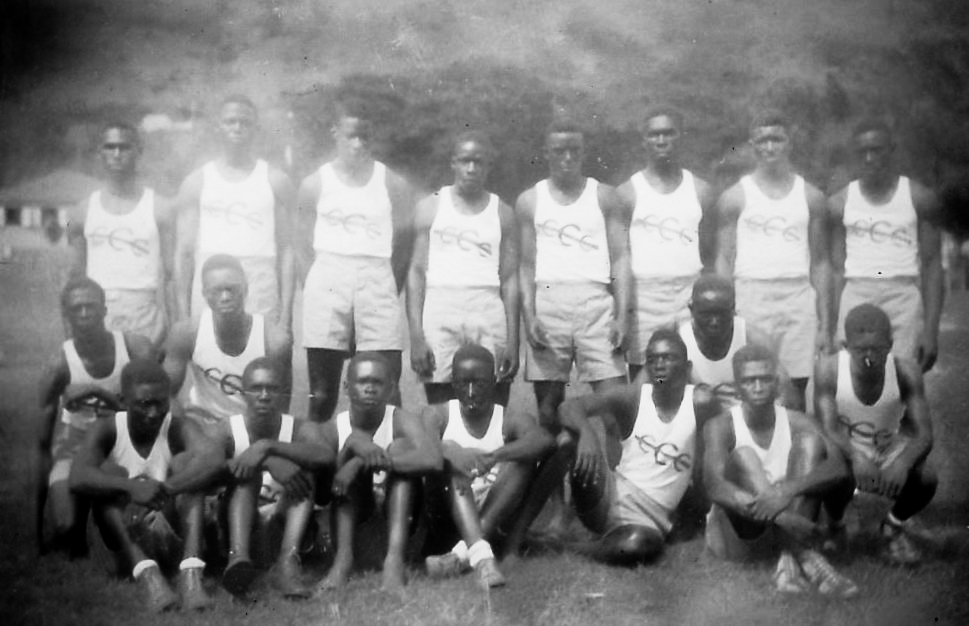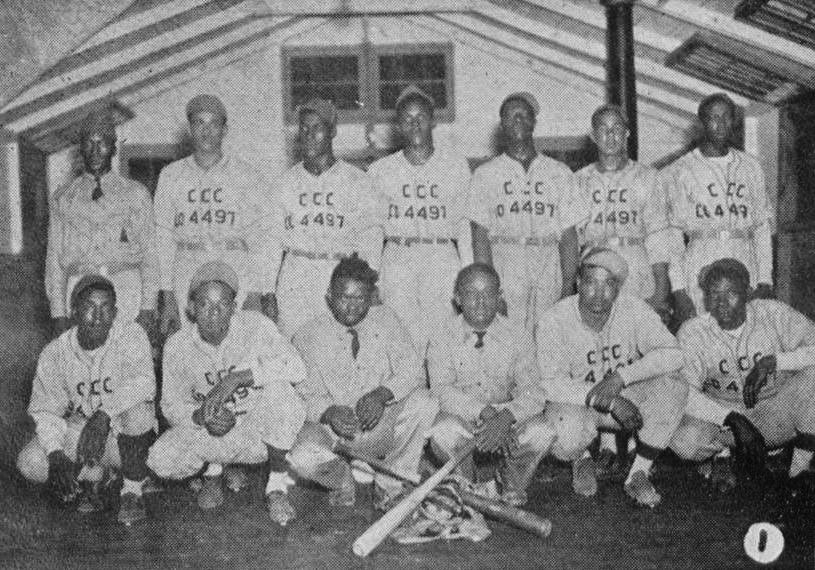- Home
- /
- Accomplishments of African Americans...
Accomplishments of African Americans in the CCC (1933-1942): Selected Examples
The purpose of this photo story is to highlight African American Civilian Conservation Corps (CCC) companies and their contributions to the conservation of America’s lands and forests and the development of state and national parks. Roughly half a million young men of African descent were enrolled in the CCC over its lifetime.

Though there were integrated camps in the CCC in the early years of the New Deal, especially outside the south, after 1935 all CCC camps were segregated, as was the common practice in housing and employment at the time. Nevertheless, African American companies made enormous contributions to the CCC’s goals and their work was a source of pride and personal development for the enrollees, as well.
1. Company C-3790, Camp P-71, Rosston, Arkansas
“All project work is devoted toward one main goal, the conservation of the American forest, and since the inception of the camp, this company has made an enviable record toward this goal.”
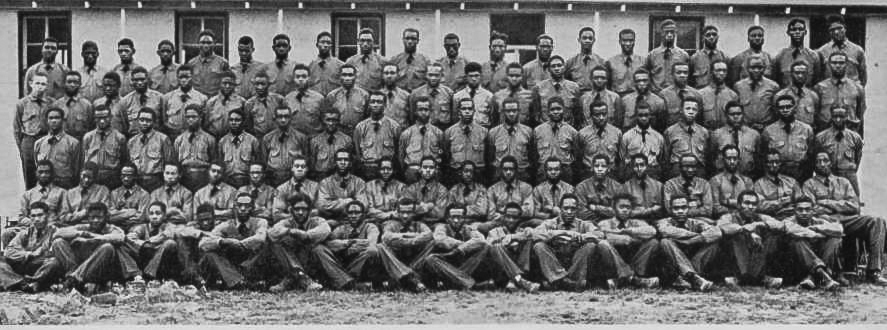
Accomplishments of Company C-3790, Camp P-71 included: 59 miles of truck trails; 193 bridges; 7 fire lookout towers; 3, 190 yards of fencing; 50 buildings constructed; 8,000 telephone poles cut; 389 miles of telephone wire installed; 50,000 trees planted; 3,800 man-days devoted to firefighting; and 2,100 man-days spent on fire prevention projects.
Source for information, quotation, and photo: Central Arkansas Library System, Official Annual, 1937, Arkansas District, Civilian Conservation Corps, Seventh Corps Area, pp. 120-121, 158, and 171 (accessed November 7, 2021).
2. Company 838 (C), Camp P-57-T, Lufkin, Texas
“Located in the heart of East Texas’ timber section, the camp devoted much of its time to fighting fires, building roads and bridges…Many men from Company 838 received very beneficial training… and a number have secured outside employment in other branches of the Forestry Service and elsewhere as a direct result of camp training.”
Accomplishments of Company 838, Camp P-57-T included: 15 fire lookout towers constructed; 155 miles of roadwork; 638 bridges (15 to 200 feet long); 83 miles of telephone lines. The roads they built were used by school buses, mail carriers, and the surrounding community.
Source for information, quotation, and photo: The History Center (Diboll, Texas), Official Annual, 1936, Civilian Conservation Corps, Lufkin District, 8th Corps Area, pp. 63-65 (accessed January 15, 2022).
3. Company 303, Camp S-84-Pa., Benezett, Pennsylvania
“The relationship between the camp and surrounding communities has always been pleasant. The camp baseball team, basketball, and track teams have participated in sports with most of these communities and proved ambassadors of goodwill in promoting better relationship.”

Accomplishments of Company 303, Camp S-84-Pa. included: Forest roads – 20 miles; foot-trails – 11 miles; roadside cleanup – 11 miles; trailside cleanup – 19 miles; stream improvement – 18 miles; firefighting – 630 man days; fire presuppression work – 430 man days; search & rescue – 25 man days.
Source for information, quotation, and photo: Pennsylvania Department of Conservation & Natural Resources, “Pennsylvania CCC Online Archive,” pp. 65-67 of the annual (accessed January 22, 2022).
4. Company 3459, Camp TVA-P-11, Counce, Tennessee
“A distinctive feature of the Company is the quartet and other groups of singers. These singers are best in presentations of Negro spirituals and folk songs. They have appeared a number of times at local communities and recently made their debut over a neighboring radio station.”

Accomplishments of Company 3459, Camp TVA-P-11 included: Working under the supervision of the National Park Service and the Tennessee Valley Authority, this company engaged in forestry work around the Pickwick Dam.
Source for information, quotations, and photo: Western Carolina University, District ‘C,’ CCC, Fourth Corps Area, 1937 Annual, pp. 172-174 and 204. (accessed January 22, 2022).
5. Company 4735, Camp SCS-18, Charlotte, Arkansas
“Recreation… has been important in the lives of the enrollees… There are innumerable games, dances, recreational trips, educational and feature length movies…”

Accomplishments of Company 4735, Camp SCS-18 included: Soil Conservation Demonstrations (i.e., showing methods to reduce soil erosion and loss) on 75 farms in Independence County, Arkansas.
Source for information, quotation, and photo: Central Arkansas Library System, Official Annual, 1937, Arkansas District, Civilian Conservation Corps, Seventh Corps Area, pp. 149-151 and 172 (accessed January 22, 2022).
6. Company 1464, Camp MP-1, Fort Oglethorpe, Georgia
“Enrollees of this Company were complimented by the District Commanding Officer for the help they rendered in the flood disaster this year.”
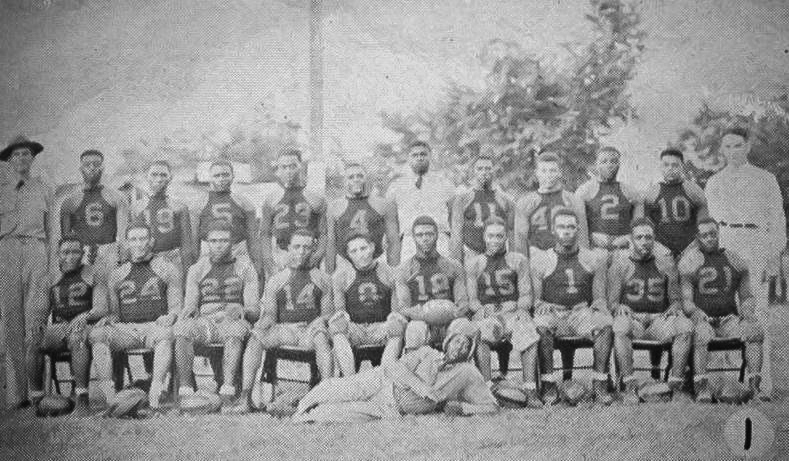
Accomplishments of Company 1464, Camp MP-1 included: “The men of this camp have worked in scenic and historic Chickamauga National Military Park, which contains 5,500 acres. The work has consisted of reducing fire hazards, landscaping, road beautification, planting and maintenance of roads… 135,000 balled and burlaped flowering trees have been planted…”
Source for information, quotation, and photo: Western Carolina University, District ‘C,’ CCC, Fourth Corps Area, 1937 Annual, pp. 151-153 and 203-204 (accessed January 22, 2022).
7. Company 2423, Camp MP-7, Corinth, Mississippi
“The company had excellent equipment for fighting forest fires and were engaged a number of times in fierce combat with forest fires, which were always subdued in short time.”
Accomplishments of Company 2423, Camp MP-7 included: Soil conservation work in the areas around the Glencoe Rifle Range (Alabama), and road beautification work on the Shiloh-Corinth Military Highway (Tennessee).
Source for information, quotation, and photo: Western Carolina University, District ‘C,’ CCC, Fourth Corps Area, 1937 Annual, pp. 166-168 (accessed January 22, 2022).
8. Company 510, Camp NP-1, Mammoth Cave, Kentucky
“This camp was the first established in Kentucky and was opened on May 22, 1933. It has been given general recognition for its contributions toward the present excellent condition of Mammoth Cave National Park.”
—Courier-Journal

Accomplishments of Company 510, Camp NP-1 included: Planting trees, “seeding gullies, controlling tree pests… improved fire detection methods… introducing new wildlife” (Schmitzer, p. 461), and “tourist trail routes [at Mammoth Cave National Park] which are still utilized today” (National Park Service).
Source for information, quotations, and photo: Jeanne Cannella Schmitzer, “CCC Camp 510: Black Participation in the Creation of Mammoth Cave National Park,” The Register of the Kentucky Historical Society, Vol. 93, No. 4 (Autumn 1995), pp. 446-464. “African American History,” Mammoth Cave National Park, National Park Service (accessed January 23, 2022). Negro C.C.C. Company Leads Kentucky’s 28 Camps In Work Achievement Rating for Almost Two Years,” Courier-Journal (Louisville, Kentucky), August 7, 1939, p. 2.
9. Company 2336, Camp S-146-Pa., Austin, Pennsylvania
“The Bark Shanty Road, leading from state highway 872 into camp, is nearing completion. The road, at one time a wagon trail, is being made a state road.”

Accomplishments of Company 2336, Camp S-146-Pa. included: Roadwork, snow removal, flood clean-up, firefighting, trail construction, and blister rust eradication.
Source for information, quotation, and photo: Pennsylvania Department of Conservation & Natural Resources, “Pennsylvania CCC Online Archive,” pp. 120-122 of the annual (accessed January 22, 2022).
10. Company 2877 (C), Camp F-21-T, Coldspring, Texas
“Among the most recent advantages given camp enrollees is the attractive reading room. Enrollees manifest their pride in the aid to self-improvement by keeping the room orderly and inviting.”
Accomplishments of Company 2877 (C), Camp F-21-T included: “The enrollees of the camp, which is a unit of the Sam Houston National Forest, played a large part in forest fire fighting… 157 miles of Federal and State roadway have been maintained, culverts and bridges have been replaced, and 40 miles of telephone lines have been replaced.”
Source for information, quotations, and photo: The History Center (Diboll, Texas), Official Annual, 1936, Civilian Conservation Corps, Lufkin District, 8th Corps Area, pp. 72-74 (accessed January 15, 2022).
11. Company 3462, Camp SCS-2, Collierville, Tennessee
“At present, the Camp is under the command of First Lieut. C.M. Burdette. During the short period of time in which [he] has been in command there have been several improvements and advantages offered in the line of recreation and education… a very necessary and worthwhile drive has also been launched for an improved health standard among members of the Company.”
Accomplishments of Company 3462, Camp SCS-2 included: “In general, the conserving of the soil is the work of the members of the Company. Very worthwhile results have been accomplished on many private farms in the surrounding territory.”
Source for information, quotations, and photo: Western Carolina University, District ‘C,’ CCC, Fourth Corps Area, 1937 Annual, pp. 175-177 of the annual (accessed January 22, 2022).
12. The Virgin Islands CCC
“The CCC planted mahogany trees throughout the Virgin Islands, including on Queen Mary Highway”
—Virgin Islands Daily News
Accomplishments of the Virgin Islands CCC included: Mosquito control, resulting in malaria reduction; grading and landscaping around public housing projects; planting trees at Calabash Boom, St. John and Sandy Point, St. Croix.
Source for information, quotation, and photo: Photo from the National Archives, Record Group 55. General work accomplishments from the U.S. Department of the Interior, Annual Report of the Governor of the Virgin Islands for the Fiscal Year Ended June 30, 1938, Washington, DC: U.S. Government Printing Office, 1938, p. 19 (contained within the larger Department of Interior annual report). Quote from, Olasee Davis, “In butchering our mahogany trees we sacrifice landmarks of our culture,” The Virgin Islands Daily News, December 11, 2017 (accessed January 23, 2022).
13. Company 4497, Camp SP-5, Burns, Tennessee
“In the recent flood crisis along the Cumberland and Mississippi Rivers, the enrollees of this Company labored valiantly… Enrollee William Snow waded the icy water of the Cumberland up to his arm pits to remove an aged lady from her home. Jesse Allen, another enrollee, braved the water and ice almost up to his neck to save an aged blind man.”
Accomplishments of Company 4497, Camp SP-5 included: Assisted the National Park Service and the Public Works Administration in the creation of Montgomery Bell State Park in Burns, Tennessee.
Source for information, quotation, and photo: Western Carolina University, District ‘C,’ CCC, Fourth Corps Area, 1937 Annual, pp. 200-201 and 204 (accessed January 22, 2022).
14. Company 3776, Camp BF-2, Dewitt, Arkansas
“Manifesting a high degree of interest in the welfare of the company, Lieut. [Alfred T.] Brown installed symphonolas [similar to jukeboxes] and introduced other phases of activity never before enjoyed [by the enrollees]. The baseball team received new uniforms and shoes… the morale of the company was high throughout this administration…”
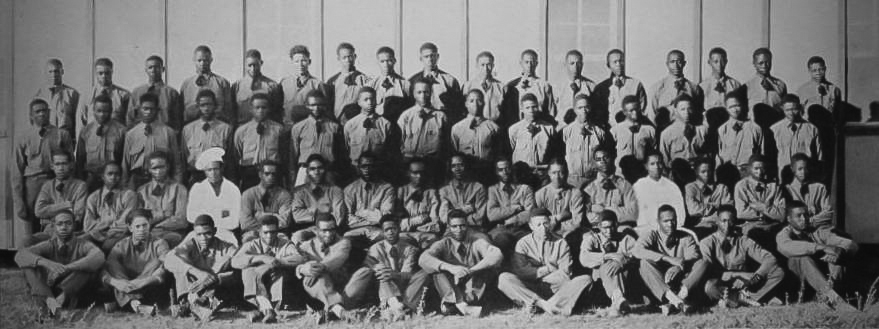
Accomplishments of Company 3776, Camp BF-2 included: Helped create the White River National Wildlife Refuge (Arkansas). The 3776th built bridges, installed culverts, made firebreaks, and more.
Source for information, quotation, and photo: Central Arkansas Library System, Official Annual, 1937, Arkansas District, Civilian Conservation Corps, Seventh Corps Area, pp. 86-89 and 168 (accessed January 22, 2022).
15. Company 2878 (C), Camp F-22-T, San Augustine, Texas
“On August 1, 1935, a cadre of 12 men was sent from Lufkin, Texas, to begin the steps of making Company 2878 (C) [“Camp Broaddus”] a matured and progressive member of the CCC, the greatest institution of its kind for natural and human rehabilitation.”
Accomplishments of Company 2878, Camp F-22-T included: 14 miles of truck trails; 38 miles of telephone lines; forest improvement on 2,000 acres; responded to 80 forest fires; and lake and pond development.
Source for information, quotation, and photo: The History Center (Diboll, Texas), Official Annual, 1936, Civilian Conservation Corps, Lufkin District, 8th Corps Area, pp. 69-71 (accessed January 15, 2022).
16. Company 4734, Camp SCS-10, Forrest City, Arkansas
“[D]uring the flood of 1937, which swept through Northeast Arkansas…This company…cooked for and fed over 6,000 refugees [flood victims]… they waded through large bodies of water and saved hundreds of lives…The educational department of Company 4734 established two reading rooms in the refugee camp, which added much to the welfare of many children as well as adults.”
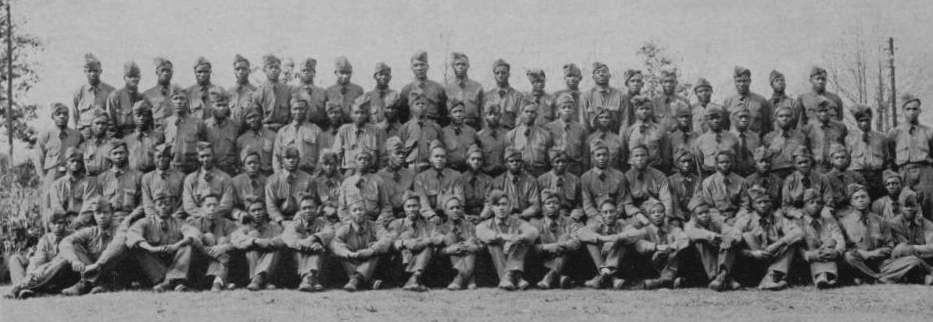
Accomplishments of Company 4734, Camp SCS-10 included: 3 and ½ miles of highway erosion control; 26,384 trees planted in gullies; 15,273 acres mapped; and topographic surveys performed for 7,911 acres.
Source for information, quotation, and photo: Central Arkansas Library System, Official Annual, 1937, Arkansas District, Civilian Conservation Corps, Seventh Corps Area, pp. 146-148 and 172 (accessed January 22, 2022).
17. Company 2890 (C), Camp SCS-25-T, Nacogdoches, Texas
“The first colored Educational Adviser in Texas, Preston Valien, was assigned to Company 2890 (C) on October 1, 1935, and under his direction the camp educational program grew rapidly and efficiently.”

Accomplishments of Company 2890 (C), Camp SCS-25-T included: “With the Soil Conservation Service the enrollees have completed several masonry dams, wire dams, and sod channels. Other projects include planting trees for nursery improvement, laying of water pipes for irrigation purposes, construction of several miles of telephone lines, and spot and strip sodding.”
Source for information, quotations, and photo: The History Center (Diboll, Texas), Official Annual, 1936, Civilian Conservation Corps, Lufkin District, 8th Corps Area, pp. 66-68 (accessed January 15, 2022).
18. Company 321, Camp S-147-Pa., Emporium, Pennsylvania
“The relationships of the camp and the community have been cordial. Amateur shows have been given in Emporium and the camp orchestra has been engaged to play at several clubs and civic organizations gaining quite a following in the community.”

Accomplishments of Company 321, Camp S-147-Pa. included: Stream improvement, foot trails, lineal surveys, forest stand improvement, firefighting, and disaster response and clean-up.
Source for information, quotation, and photo: Pennsylvania Department of Conservation & Natural Resources, “Pennsylvania CCC Online Archive,” pp. 102-104 of the annual (accessed January 22, 2022).
19. CCC companies at Colonial National Historical Park (Yorktown and Jamestown), Virginia
“For a decade the CCC actively restored the park’s landscape, and much of the innovative work accomplished during the 1930s was done so only because of their involvement” (HAER)

Accomplishments of companies at Colonial National Historical Park included: Landscaped the grounds; removed dead trees and other wildfire fuel; assisted in the construction and beautification of Colonial Parkway; reconstructed and protected important battle sites; cleared old colonial roads; made foot and horse trails; restored and constructed buildings; built historically accurate furniture and cannons; and assisted with archaeology excavations.
Source for information, quotation, and photo: Various editions of the newspapers Daily Press (Newport News, Virginia) and The Times Dispatch (Richmond, Virginia), 1933-1941. “Colonial National Historical Park Roads and Bridges,” Historic American Engineering Record, HAER No. VA-115, 1995, Library of Congress (accessed January 16, 2022). See the Living New Deal’s several project pages for Colonial National Historical Park: here, here, here, here, and here.
20. Company 2314, Camp ANF-12-Pa., Kane, Pennsylvania
“Members of the Radio Class erected a radio building, complete in every detail, which housed the radio equipment and provided and operator’s office as well as classroom for the radio and aviation groups. Leader Ernest Paxton and Enrollee Henry Fuller passed their examinations for Amateur Radio Operator licenses.”

Accomplishments of Company 2314, Camp ANF-12-Pa. included: This company was heavily involved in roadwork, such as installing culverts, quarrying stone, masonry work, and “keeping open snow drifted roads during the severe winter of 1935-1936.” The company also experimented with methods of using radios to help fight fires: “It is now possible for fire-fighting crews equipped with portable sets to communicate with the radio station at the base camp” (The Indiana Gazette).
Source for information, quotations, and photo: Pennsylvania Department of Conservation & Natural Resources, “Pennsylvania CCC Online Archive,” pp. 40-42 of the annual (accessed January 22, 2022). “Radio Training: Navy Officer Trains Enrollees In Wireless Theory,” The Indiana Gazette (Indiana, Pennsylvania), July 7, 1937, p. 12.
21. Company 2425, Camp MP-3, Pittsburg Landing, Tennessee
“Company 2425, Camp Young, had its beginning at Fort Oglethorpe, Georgia, June 27, 1933. Sixty World War veterans made up the chartered membership. On July 15, 1933, these sixty men moved west to Pittsburg Landing, Tennessee.”
Accomplishments of Company 2425, Camp MP-3 included: At Shiloh National Military Park: Road maintenance; 7 miles of firebreaks; removal of wildfire fuel; 2,039 erosion dams; tree surgery; moving and planting trees; 16 acres of picnic ground; and planted Bermuda grass over 80 acres.
Source for information, quotation, and photo: Western Carolina University, District ‘C,’ CCC, Fourth Corps Area, 1937 Annual, pp. 169-171 (accessed January 22, 2022).




